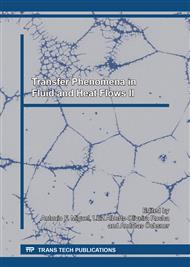[1]
Xu, J.; Wang, R.Z.; Li, Y. 2014. A review of available technologies for seasonal thermal energy storage,. Solar Energy. 103: 610-638.
DOI: 10.1016/j.solener.2013.06.006
Google Scholar
[2]
Kenisarin, M; Mahkamov, K. 2007. Solar energy storage using phase change materials,. Renewable and Sustainable Energy Reviews 11: 1913–(1965).
DOI: 10.1016/j.rser.2006.05.005
Google Scholar
[3]
Prakash, J; Garg, H. P; Datta, G. 1985. A solar water heater with a built-in latent heat storage,. Energy Convers. Mgmt Vol. 25, No. 1, pp.51-56.
DOI: 10.1016/0196-8904(85)90069-x
Google Scholar
[4]
Pielichowska, K.; Pielichowski, K. 2014. Phase change materials for thermal energy storage,. Progress in Materials Science. 65: 67–123.
DOI: 10.1016/j.pmatsci.2014.03.005
Google Scholar
[5]
Dutil, Y.; Rousse, D.R.; Salah, N.B.; Zalewski, L.L. 2011. A review on phase-change materials: Mathematical modeling and simulations,. Renewable and Sustainable Energy Reviews. 15: 112–130.
DOI: 10.1016/j.rser.2010.06.011
Google Scholar
[6]
Mawire, A; Mcpherson, M. 2009. Experimental and simulated temperature distribution of an oil-pebble bed thermal energy storage system with a variable heat source,. Applied Thermal Engineering 29.
DOI: 10.1016/j.applthermaleng.2008.05.028
Google Scholar
[7]
Oró, Eduard; Chiu, J; Martin, V; Cabeza, L. F. 2013. Comparative study of different numerical models of packed bed thermal energy storage systems,. Applied Thermal Engineering 50: 384-392.
DOI: 10.1016/j.applthermaleng.2012.07.020
Google Scholar
[8]
Karthikeyan, S; Solomon, G. R; Kumaresan, V; Velraj, R. 2014. Parametric studies on packed bed storage unit filled with PCM encapsulated spherical containers for low temperature solar air heating applications,. Energy Conversion and Management 78: 74–80.
DOI: 10.1016/j.enconman.2013.10.042
Google Scholar
[9]
Kao, M.T.; Tung, Y.H.; Y.M. Ferng, Y.M.; Chieng, C.C. 2014. Investigating effects of sphere blockage ratio on the characteristics of flow and heat transfer in a sphere array energy,. Conversion and Management. 81: 455-464.
DOI: 10.1016/j.enconman.2014.02.057
Google Scholar
[10]
Assis, E.; Katsman, G.; Ziskind, G.; Letan, R. 2007. Numerical and experimental study of melting in a spherical shell,. International Journal of Heat and Mass Transfer. 50: 1790-1804.
DOI: 10.1016/j.ijheatmasstransfer.2006.10.007
Google Scholar
[11]
Tan, F.L. 2008. Constrained and unconstrained melting inside a sphere. International Communications in Heat and Mass Transfer, v. 35, pp.466-475.
DOI: 10.1016/j.icheatmasstransfer.2007.09.008
Google Scholar
[12]
Hosseinizadeh, S.F.; Darzi, A.A.R.; Tan, F.L.; Khodadadi, J.M. 2013. Unconstrained melting inside a sphere. International Journal of Thermal Sciences, v. 63, pp.55-64.
DOI: 10.1016/j.ijthermalsci.2012.07.012
Google Scholar
[13]
Ziye, L., Zhang, Z., Shi, G., Fang, X., Wang, L., Gao, X., Fang, Y., Xu, Wang, S., Liu, X. 2014. Review on thermal management systems using phase change materials for electronic components, Li-ion batteries and photovoltaic modules, Renewable and Sustainable Energy Reviews. 31: 427-438.
DOI: 10.1016/j.rser.2013.12.017
Google Scholar
[14]
Zhou, D.; Zhao, C.Y.; Tian, Y. 2012. Review on thermal energy storage with phase change materials (PCMs) in building applications., Applied Energy. 92: 593-605.
DOI: 10.1016/j.apenergy.2011.08.025
Google Scholar
[15]
Voelker, Conrad; Kornadt, O; Ostry, M. 2008. Temperature reduction due to the application of phase change materials,. Energy and Buildings 40: 937–944.
DOI: 10.1016/j.enbuild.2007.07.008
Google Scholar
[16]
Sánchez, P; Sánchez-Fernandez, M. V; Romero, A; Rodríguez, J. F; Sánchez-Silva, L. 2010. Development of thermo-regulating textiles using paraffin wax microcapsules,. Thermochimica Acta 498: 16–21.
DOI: 10.1016/j.tca.2009.09.005
Google Scholar
[17]
Oró , E; Miró, L; Farid , M. M; Cabeza, F.L. 2012. Improving thermal performance of freezers using phase change materials,. International journal of refrigeration 35: 984-991.
DOI: 10.1016/j.ijrefrig.2012.01.004
Google Scholar
[18]
Ohkawara, H; Kitagawa, T; Fukushima, N; Ito, T; Sawa, Y; Yoshimine, T. 2012. A newly developed container for safe, easy, and cost-effective overnight transportation of tissues and organs by electrically keeping tissue or organ temperature at 3 to 6°C,. Transplantation Proceedings 44: 855-858.
DOI: 10.1016/j.transproceed.2012.02.023
Google Scholar
[19]
Brent, A.D.; Voller, V.R. 1988. Enthalpy-porosity technique for modeling convection-diffusion phase change – application to the melting of a pure metal,. Numerical Heat Transfer. 13: 297-318.
DOI: 10.1080/10407788808913615
Google Scholar
[20]
Shmueli, H.; Ziskind, G.; Letan, R. 2010. Melting in a vertical cylindrical tube: Numerical investigation and comparison with experiments,. International Journal of Heat and Mass Transfer. 53: 4082-4091.
DOI: 10.1016/j.ijheatmasstransfer.2010.05.028
Google Scholar


